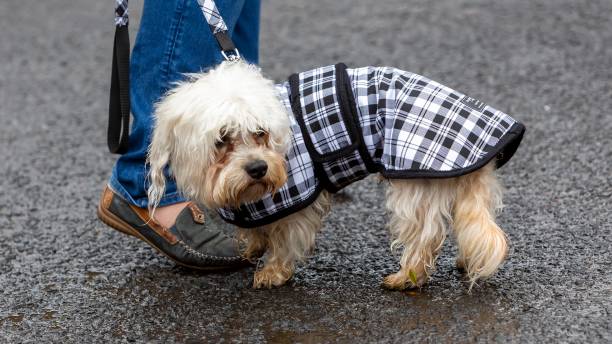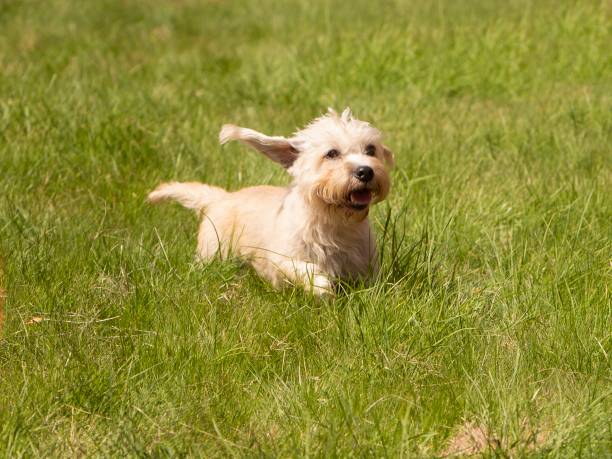Dandie Dinmont Terrier

Breed History:
The Dandie Dinmont Terrier is a distinctive and rare breed that originated in the border region between Scotland and England during the 1700s. Bred by gypsies and farmers to hunt badgers and otters, the Dandie is one of the oldest known terrier breeds.
The breed gained its name from a character in Sir Walter Scott’s 1815 novel Guy Mannering, in which a farmer named Dandie Dinmont kept a pack of unique-looking terriers. The dogs described in the book closely matched those already used in the border country, and the name stuck.
While it shares ancestry with breeds like the Border Terrier and Skye Terrier, the Dandie Dinmont has a distinct appearance and personality, leading to its recognition as a separate breed. It was one of the first terriers to be exhibited in dog shows in the mid-19th century.
Height: 20-28 cm
Weight: 8-11 kg
Size – Small
Life Expectancy: 12–15 years

Breed Appearance:
The Dandie Dinmont Terrier is unmistakable with its long, low-slung body, large domed head, and unique "topknot" of soft hair on the crown. The body is covered with a crisp, double coat—harder on top, soft underneath.
Its large, expressive eyes and low-hanging ears give it a gentle, wise expression. The Dandie’s tail is short, curved like a scimitar, and carried slightly upward.
Coat colors include:
-
Pepper: blue-black to silvery gray
-
Mustard: reddish fawn to pale cream
The breed matures slowly, often not reaching full coat and color until around two years of age.
Breed Type – Companion/Hunting Terrier:
Originally bred for hunting vermin and burrowing animals, the Dandie Dinmont Terrier has retained its tenacity and courage, but is also an affectionate and calm companion. Unlike more excitable terriers, the Dandie is more laid-back, often described as “gentlemanly.”
Dandies form strong bonds with their families and are good with older children. They are alert and protective, but not overly yappy, making them excellent watchdogs.

Training:
Dandie Dinmonts are intelligent, independent, and slightly stubborn, which can make training a challenge for first-time owners. However, they are very loyal and respond well to positive reinforcement methods like treats and praise.
Training should be firm but patient, with early socialization to help avoid suspiciousness toward strangers or other animals. They excel in obedience and earthdog trials when properly motivated.
Health & Care:
Generally a healthy and hardy breed, the Dandie Dinmont Terrier is subject to a few hereditary issues:
-
Intervertebral disc disease (IVDD) due to its long back
-
Glaucoma and other eye disorders
-
Hypothyroidism
-
Canine cancer (less commonly)
Routine health screening, moderate activity, and a proper diet can help ensure long-term health.
Living Conditions:
Dandie Dinmont Terriers adapt well to apartment living or homes with small yards, provided they get daily exercise. They are quiet indoors, making them ideal for urban environments.
Because of their strong prey drive, outdoor play should take place in a securely fenced area or on a leash. While they enjoy lounging, they still require daily stimulation to prevent boredom.
They do well in multi-pet households if raised together and properly socialized, though they may chase small animals like rodents.

Exercise:
Despite their short legs, Dandies are energetic and need regular exercise. A daily walk combined with some interactive play or backyard exploration usually suffices. They enjoy digging and sniffing, which reflects their working background.
Mental enrichment like puzzle toys or scent work is also valuable. Though not hyperactive, they need regular engagement to stay fit and content.
Grooming:
The Dandie’s coat requires regular grooming to maintain its texture and appearance:
-
Brushing 2–3 times per week to prevent matting
-
Hand-stripping or professional grooming every 6–8 weeks
-
Regular trimming of the topknot to maintain breed standards
Routine ear cleaning, dental hygiene, and nail trimming are essential. The breed sheds minimally and is often considered low-allergen.

Advantages:
-
Distinctive appearance and gentle expression
-
Calm and affectionate—ideal house companion
-
Good watchdog with minimal barking
-
Adaptable to apartment or country life
-
Low-shedding and relatively clean
-
Loyal and bond strongly with family
Disadvantages:
-
Can be stubborn or slow to train
-
Needs professional grooming or hand-stripping
-
Prone to back issues if overweight or improperly exercised
-
Reserved with strangers if not well-socialized
-
Rare breed—can be hard to find

